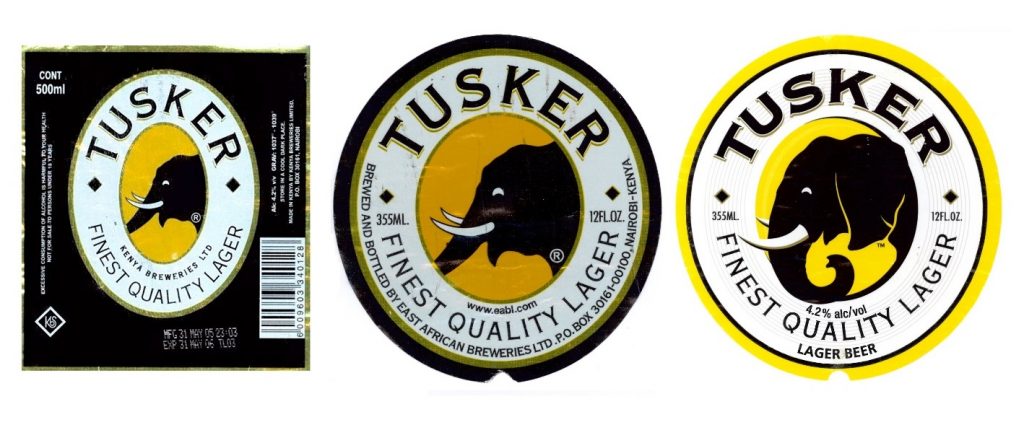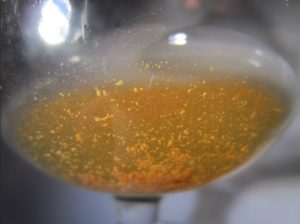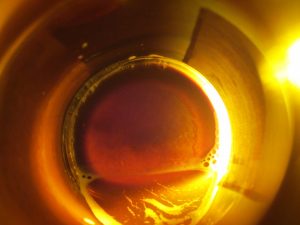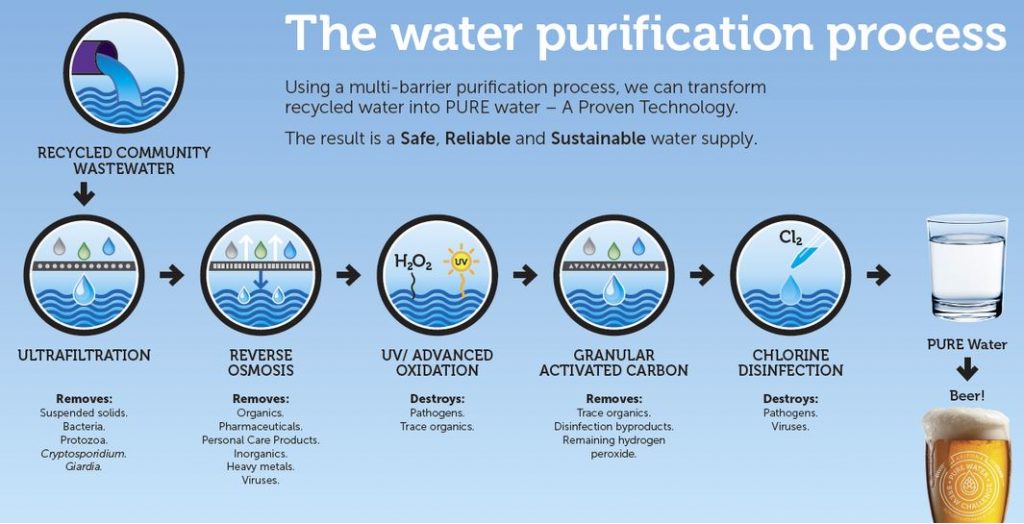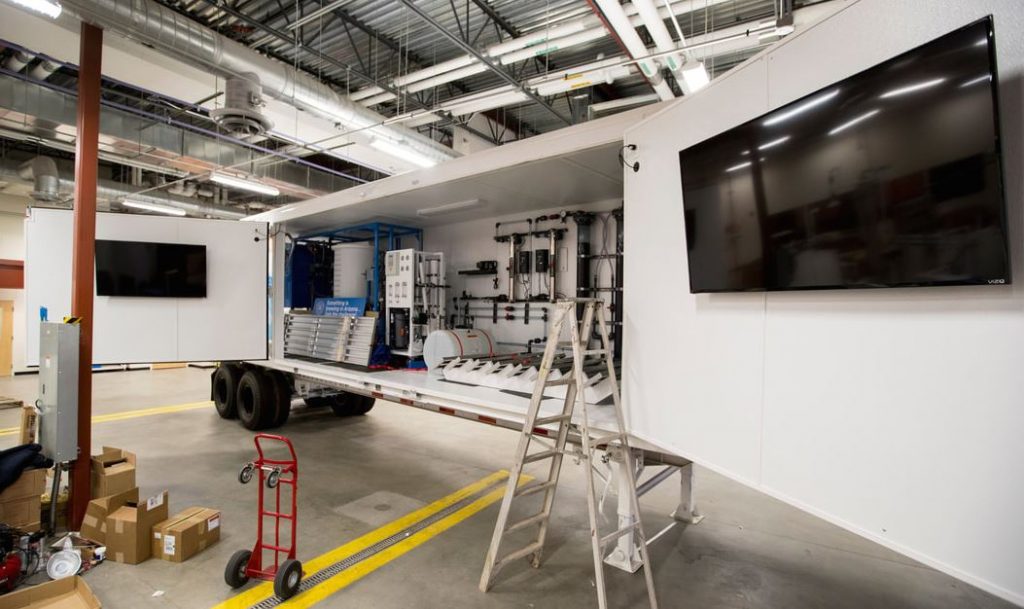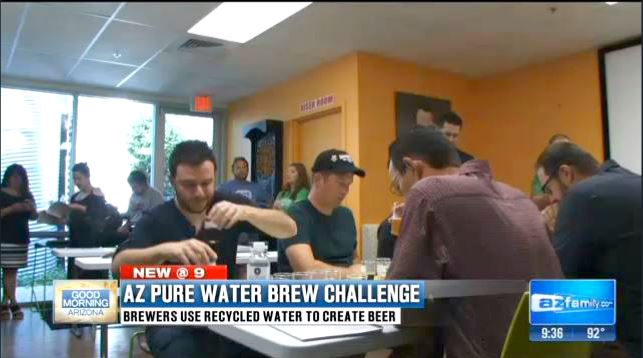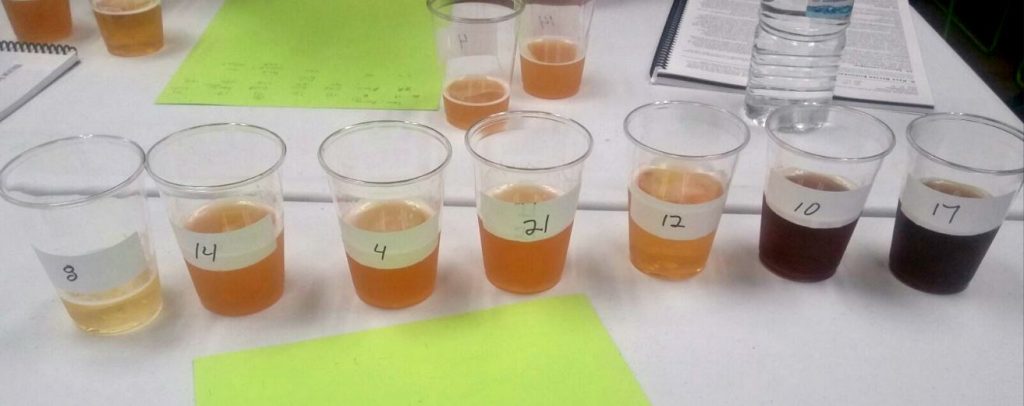Once upon a time, “Sierra Nevada Beer Camp” meant the rare and exciting chance that you, lucky member of the general public, could literally win a golden ticket à la Willy Wonka to attend “Beer Camp” at the Sierra Nevada brewery in Chico, CA.
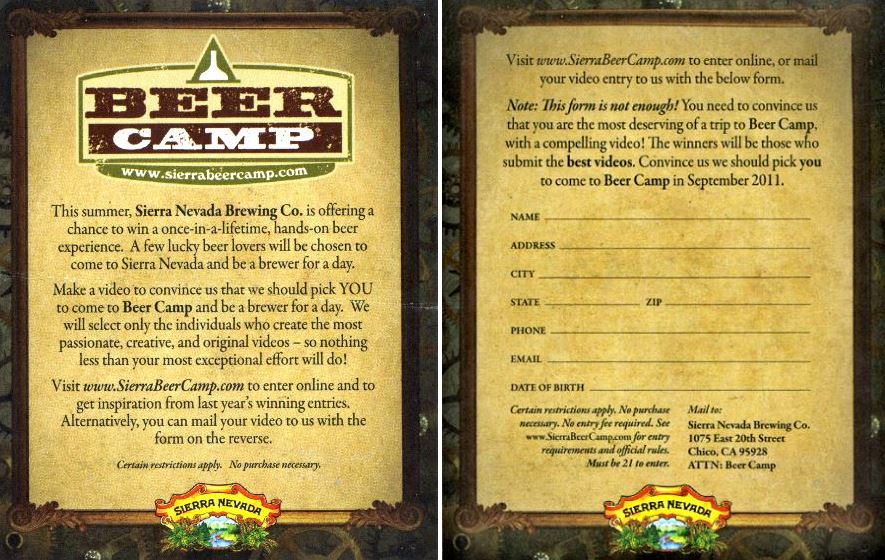
Winning not only meant hanging out and sipping rare brews with the crew at Sierra Nevada (SN), but even better it meant creating your very own special beer at the SN brewery to be served at a local hometown bar of your choosing with the potential to have that very same beer of yours get national distribution as part of a Sierra Nevada Beer Camp mix pack.
Those were the days…
Since 2014 though, the Beer Camp variety pack has come to mean a mix of collaboration beers brewed with other professional breweries, which of course brings a kind of excitement of its own.
First teaming up with only U.S. breweries in 2014 and 2016, this year the hop-obsessed Sierra Nevada went global with its one-time-only mixed 12-pack by joining forces with six of the biggest international names in the industry including Mikkeller, Duvel Moortgat, Ayinger, Fullers, Garage Project and Kiuchi, but still kept one foot firmly planted stateside with collabs from six well-regarded U.S. breweries such as Avery, Surly, Saint Arnold, The Bruery, Boneyard Beer, and the much raved about rising star that is Tree House.
But even with this roster of heavy hitters in play, let’s face it: as with music, brewing collaborations can be something of a crapshoot with struggles for creative control being but one of several possible hurdles. Best case scenario, the resulting double-team brew can be a product greater than the sum of the breweries involved. In other cases, the concept beer just doesn’t capture the magic hoped for.
In all cases though, expecting perfection from every collaboration beer is not exactly realistic, especially from a first-and-last attempt at a new recipe by breweries of differing strengths and focuses.
That said, we found this year’s lineup was, well, good with enough variety to keep things interesting. Some hits, some misses, but on average we give the mix pack an 80/100. For what it’s worth, both the BeerAdvocate (BA) and RateBeer (RB) general users scored the 2017 Beer Camp variety pack an average of about 85/100 with the most hop-forward beers scoring the highest, and the fruit and spiced beers scoring the lowest, as is the fashion at the moment.
So without further ado, the following is how the 2017 Beer Camp Across the World shakes out in ascending order of greatness as determined by a panel of mostly BJCP beer judges scored according to the current BJCP Beer Style Guidelines:
Sierra Nevada 2017 Beer Camp Across the World Review
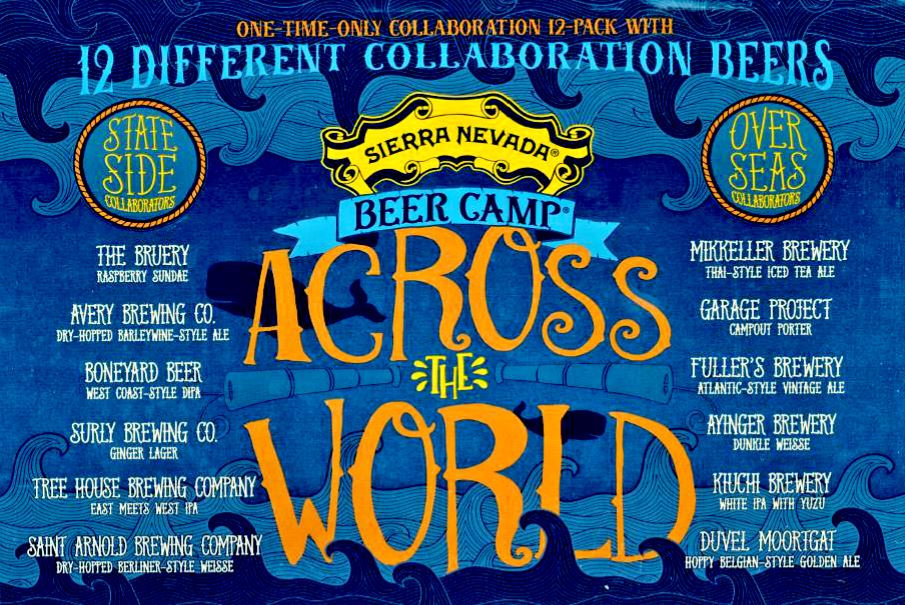
[Packaged in April 2017, Sampled May, 2017]
12. Ginger Lager: (Sierra Nevada & Surly Brewing Co.)
The Gist: This mega ginger-spiced lager tickles the nose and heats the palate, showcasing notes of ginger, more ginger and also ginger. Feel the burn.
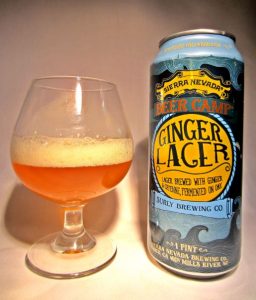 Description: Pours a finger of foamy off-white head over a clear honey gold-colored body. Heaps of ginger burst forward in the aroma followed by eucalyptus and juicy crushed oleander leaves, apple juice, light honey, toasted caramel malt, and wool sweater. The flavor leads with tingly raw acidic ginger spice and peppery oleander leaves, followed by radish, citrus leaf, and lemon. The hot ginger spice burn increases with subsequent sips, leaving behind an aftertaste with notes of oleander and turnip.
Description: Pours a finger of foamy off-white head over a clear honey gold-colored body. Heaps of ginger burst forward in the aroma followed by eucalyptus and juicy crushed oleander leaves, apple juice, light honey, toasted caramel malt, and wool sweater. The flavor leads with tingly raw acidic ginger spice and peppery oleander leaves, followed by radish, citrus leaf, and lemon. The hot ginger spice burn increases with subsequent sips, leaving behind an aftertaste with notes of oleander and turnip.
Label text: “The abrasive attitude of Minnesota’s Surly Brewing Co. brings an aggressive yet refined approach to creating recipes. We came together to create this easy-drinking but complex ginger-infused lager. It’s brewed with hot ginger and a pinch of cayenne to spice up the heat and then dry hopped with an inclusion of oak for a touch of woody vanilla to round out the flavor.”
11. Atlantic Style Vintage Ale: (Sierra Nevada & Fuller’s)
The Gist: As the label text suggests, this strong ale might be perfect for aging.
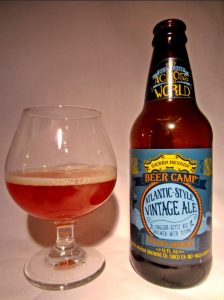 Description: Pours a fat finger of frothy tan head that slowly dissipates over 40 seconds to reveal a hazy deep copper body. Aroma: light pomegranate, Welch’s grape juice, Citrus leaves, light citrus blossom, strawberry shortcake, mild toast, light caramel syrup, candied tangerine, stewed pluots, and warming alcohol. The first sip confronts the taste buds with bitter undertones of tart unripe fruit, blueberry syrup, pithy candied tangerine, and a medium-high plum sweetness offset by a singular bitter, astringent hop character with a solvent-y alcohol finish lingering into a bitter aftertaste.
Description: Pours a fat finger of frothy tan head that slowly dissipates over 40 seconds to reveal a hazy deep copper body. Aroma: light pomegranate, Welch’s grape juice, Citrus leaves, light citrus blossom, strawberry shortcake, mild toast, light caramel syrup, candied tangerine, stewed pluots, and warming alcohol. The first sip confronts the taste buds with bitter undertones of tart unripe fruit, blueberry syrup, pithy candied tangerine, and a medium-high plum sweetness offset by a singular bitter, astringent hop character with a solvent-y alcohol finish lingering into a bitter aftertaste.
Label text: “Fuller’s Brewery in London has been producing some of the UK’s finest ales since the mid-19th century. Together we created a new recipe for an Atlantic-Style Vintage Ale—a robust beer, perfect for aging, and brewed with plums for a touch of rich fruit flavor that both mimics and enhances the natural yeast-driven aromas.”
10. White IPA with Yuzu: (Sierra Nevada & Kiuchi)
The Gist: Big exciting lemon aromatics followed up with unrelenting bitter lemon pith flavors in the taste.
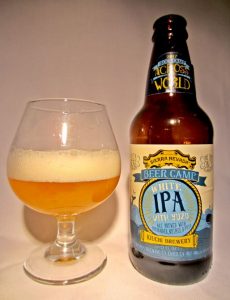 Description: Forms a half finger of whipped egg white colored creamy head that fades over 30 seconds to reveal a lightly hazy deep gold body. Aromatics include lemon candy shell, lemon grass, citrus leaf, mild grapefruit, angel food cake, a hint of Crispix cereal, and vanilla Tootsie roll. Flavor impression include spicy lemon zest, hops, dry grain, lemon oil, mild booze, white roses, yellow grapefruit, with a pithy citrus bitterness and a touch of lemon grass lingering into the aftertaste.
Description: Forms a half finger of whipped egg white colored creamy head that fades over 30 seconds to reveal a lightly hazy deep gold body. Aromatics include lemon candy shell, lemon grass, citrus leaf, mild grapefruit, angel food cake, a hint of Crispix cereal, and vanilla Tootsie roll. Flavor impression include spicy lemon zest, hops, dry grain, lemon oil, mild booze, white roses, yellow grapefruit, with a pithy citrus bitterness and a touch of lemon grass lingering into the aftertaste.
Label text: “Japan’s Kiuchi Brewery, makers of the Hitachino Nest beers, have an elegant take on classic beer styles with a uniquely Japanese influence. They suggested adding yuzu—an Asian citrus fruit—to a hazy white IPA and we jumped at the chance. What emerged is a hoppy yet refined version of the style with a bright citrus flavor and a spicy finish.”
9. Dry-Hopped Berliner-Style Weisse: (Sierra Nevada & Saint Arnold)
The Gist: Combining two of the most popular beer trends (hoppy + sour) equals automatic winner, right? Perhaps, though in Sierra Nevada’s Dry-Hopped Berliner-Style Weisse the hop character was subtle if at all noticeable in an otherwise lemon-centric, slightly salty sour ale.
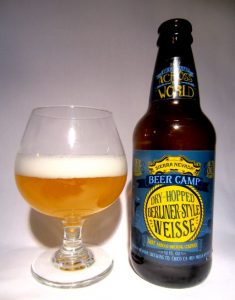 Description: A hard pour forms nearly an inch of pillow-y soft peaks of slowing fading off-white head, revealing a hazy lemon pie filling-colored body. Aromatics of Lemonhead candy, Lemon-Lime Gatorade, salt, ReaLemon plastic bottle, yeast, pound cake with lemon icing, and nearly undetectable hops. Lemon certainly is the star of the show in the flavor of this light-bodied Berliner with notes of sour lemon juice, lemon grass, followed by Sun Chips, a touch of cumin, and a hint of dry gin, leaving behind and aftertaste of yeast, lemon and cumin.
Description: A hard pour forms nearly an inch of pillow-y soft peaks of slowing fading off-white head, revealing a hazy lemon pie filling-colored body. Aromatics of Lemonhead candy, Lemon-Lime Gatorade, salt, ReaLemon plastic bottle, yeast, pound cake with lemon icing, and nearly undetectable hops. Lemon certainly is the star of the show in the flavor of this light-bodied Berliner with notes of sour lemon juice, lemon grass, followed by Sun Chips, a touch of cumin, and a hint of dry gin, leaving behind and aftertaste of yeast, lemon and cumin.
Label text: “Texas’ Saint Arnold Brewery takes a broad view of beer styles, mastering everything from traditional German-inspired recipes to big experimental creations. Together, we teamed up to brew this dry-hopped Berliner-Style Weisse. Featuring a fruit-forward hop character backed up by a snap of mild tartness, it boasts a flavor that’s complex, compelling and very drinkable.”
8. Raspberry Sundae Ale: (Sierra Nevada & The Bruery)
The Gist: Raspberry syrup, vanilla and alcohol muffle out most of the cocoa in this blonde ale.
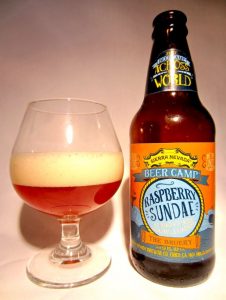 Description: Forms a finger of light tan head lasting about 40 seconds over a hazy amber brown body. Aromatics include vanilla Tootsie Roll, raspberry IHOP syrup, raspberry lip gloss, doll hair, raspberry-swirl vanilla ice cream, no hops, faint alcohol, and dry raspberry shortbread cookie. Lactose contributes to the medium-full, slightly waxy mouthfeel in this powdered sugar sweet ale that exhibits flavors of light raspberry syrup, strawberry Starburst, raspberry Fun Dip powder, vanilla powder, light malt, finishing with hot booze, leaving behind an alcoholic and somewhat husky tannic aftertaste.
Description: Forms a finger of light tan head lasting about 40 seconds over a hazy amber brown body. Aromatics include vanilla Tootsie Roll, raspberry IHOP syrup, raspberry lip gloss, doll hair, raspberry-swirl vanilla ice cream, no hops, faint alcohol, and dry raspberry shortbread cookie. Lactose contributes to the medium-full, slightly waxy mouthfeel in this powdered sugar sweet ale that exhibits flavors of light raspberry syrup, strawberry Starburst, raspberry Fun Dip powder, vanilla powder, light malt, finishing with hot booze, leaving behind an alcoholic and somewhat husky tannic aftertaste.
Label text: “The Bruery in Orange County is famous for its experimental , Belgian-style and barrel-aged beers, and this release fits nicely in their wheelhouse. Inspired by the flavors of an ice cream sundae, this rich blonde ale features cocoa, vanilla and raspberry, with lactose added for extra creaminess. Now you can have your dessert and drink it, too.”
7. West Coast Style DIPA: (Sierra Nevada & Boneyard)
The Gist: Sierra Nevada’s “West Coast Style DIPA” was rated the highest of the 2017 Beer Camp mix by RateBeer with a near perfect score of 98%, and second highest on BeerAdvocate at 89/100. In case it wasn’t clear already, big hoppy beers are the unquestioned popular champions of the American craft beer scene, no doubt about it. While enjoyable, the beer could benefit from more of a malty backbone and a bit more body to elevate it clearly out of IPA territory and squarely into Double IPA land.
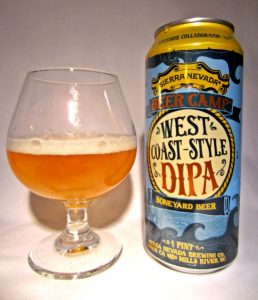 Description: Pours a thick thumb of foamy off-white head which slowly fades over 45 seconds to reveal a nearly clear deep gold body. The aroma offers up notes of pink grapefruit gelato, mild vanilla, dried mango, pepper tree bark, pine resin, colored marshmallows, dry malt extract, a hint of corn tortilla, pineapple leaves, freezer frost, a touch of salt flakes and pineapple yogurt. Flavor impressions include grapefruit Sunkist Fruit Gem candy, pine needles & resin, a touch of vanilla, mild canned peaches, and a medium sugar cane sweetness cut with a sharp green pepper corn spiciness. West Coast Style DIPA finishes boozy, leaving behind hop-derived perfume-y notes and balsa wood in the aftertaste.
Description: Pours a thick thumb of foamy off-white head which slowly fades over 45 seconds to reveal a nearly clear deep gold body. The aroma offers up notes of pink grapefruit gelato, mild vanilla, dried mango, pepper tree bark, pine resin, colored marshmallows, dry malt extract, a hint of corn tortilla, pineapple leaves, freezer frost, a touch of salt flakes and pineapple yogurt. Flavor impressions include grapefruit Sunkist Fruit Gem candy, pine needles & resin, a touch of vanilla, mild canned peaches, and a medium sugar cane sweetness cut with a sharp green pepper corn spiciness. West Coast Style DIPA finishes boozy, leaving behind hop-derived perfume-y notes and balsa wood in the aftertaste.
Label text: “We just love brewing hoppy beers” is the way Oregon’s IPA masters at Boneyard Beer kicked off our collaboration talks. Well, as it turns out, we do, too, so we went all out on this intensely hop-heavy West Coast-style Double IPA. It’s bright golden, crisp and brimming with intense citrus and herbal hop flavor, just how we like ’em.”
6. East Meets West IPA: (Sierra Nevada & Tree House)
The Gist: Not surprisingly, this hop-heavy IPA was the highest rated of this year’s beer camp series per BeerAdvocate with a solid 90/100 and a staggering 97% per RateBeer. No doubt a solid IPA, with the West coast characteristics outshining the East.
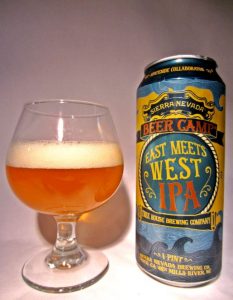 Description: Pours about a finger of fluffy off-white head which lasts nearly a minute on top of a hazy golden apricot syrup colored body. The aroma is citrus-forward with sweet notes of orange creamsicle, orange blossom, citrus leaf, tangerine and a hint of lemon and grapefruit peel followed by elements of grassy sweet alfalfa sprouts, pepper tree leaf, light pine resin and cedar, somewhat reminiscent of Sierra Nevada’s Torpedo IPA. The first flavor impression is pithy citrus peel, tangerine, lemon and grapefruit peel that while on the sharp side, the edge is slightly rounded by a reduced hop bitterness and mild vanilla orange creamsicle note. Medium –low malt sweetness balanced by white notes of pepper and salt.
Description: Pours about a finger of fluffy off-white head which lasts nearly a minute on top of a hazy golden apricot syrup colored body. The aroma is citrus-forward with sweet notes of orange creamsicle, orange blossom, citrus leaf, tangerine and a hint of lemon and grapefruit peel followed by elements of grassy sweet alfalfa sprouts, pepper tree leaf, light pine resin and cedar, somewhat reminiscent of Sierra Nevada’s Torpedo IPA. The first flavor impression is pithy citrus peel, tangerine, lemon and grapefruit peel that while on the sharp side, the edge is slightly rounded by a reduced hop bitterness and mild vanilla orange creamsicle note. Medium –low malt sweetness balanced by white notes of pepper and salt.
Label text: “In just a few short years, Tree House has made a big impact on the beer scene with their approach to the IPA – low bitterness, intense juicy hop flavor and unfiltered haze. As fellow lovers of the IPA, we combined our styles – the classic American IPA malt body and the New England approach to hopping- resulting in lightly bitter, unfiltered beer with huge hop flavor.”
5. Dunkle Weisse: (Sierra Nevada & Ayinger)
The Gist: If there was any tug-of-war for creative control in this collaboration, Ayinger clearly won with this exceptionally traditional, well balanced stylistically accurate Dunkle Weisse.
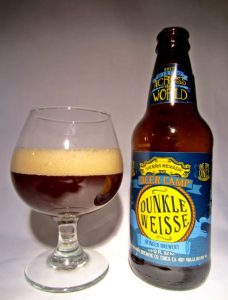 Description: Pours two fingers of exceptionally fluffy, oatmeal-colored head that lasts well over a minute over a cloudy milk chocolate colored body (plenty of yeast sediment at the bottom of the bottle). Mild note of fresh banana (plantain chips) in the aroma followed by Nilla Wafers cookie, rum raisin ice cream, malt-forward toasted dark wheat raisin bread, no hops and only very faint alcohol. Nilla Wafers cookies make an encore in the flavor along with a touch of chocolate, faint graham cracker, mildly tannic walnut/almond/pecan shell nuttiness, rye chip, medium/ medium high body, some alcohol warmth mid-palate, medium-high carbonation, very light roast, medium sweet, medium-low bitterness, but no hop flavor. Hint of anise in the finish. The aftertaste leaves a pleasant vanilla shake impression with yeast and mild toast.
Description: Pours two fingers of exceptionally fluffy, oatmeal-colored head that lasts well over a minute over a cloudy milk chocolate colored body (plenty of yeast sediment at the bottom of the bottle). Mild note of fresh banana (plantain chips) in the aroma followed by Nilla Wafers cookie, rum raisin ice cream, malt-forward toasted dark wheat raisin bread, no hops and only very faint alcohol. Nilla Wafers cookies make an encore in the flavor along with a touch of chocolate, faint graham cracker, mildly tannic walnut/almond/pecan shell nuttiness, rye chip, medium/ medium high body, some alcohol warmth mid-palate, medium-high carbonation, very light roast, medium sweet, medium-low bitterness, but no hop flavor. Hint of anise in the finish. The aftertaste leaves a pleasant vanilla shake impression with yeast and mild toast.
Label text: “Bavaria’s Ayinger are legends in the brewing industry, known for their love and perfection of classic German beer styles. Playing off their background, we came together to create this dark twist on the Bavarian-style wheat beer. This beer features layers of wheat malt flavor and was handled through traditional open fermenters to highlight Ayinger’s famous Hefeweizen yeast character.”
4. Dry-Hopped Barleywine-Style Ale: (Sierra Nevada & Avery)
The Gist: One of the highlights of the pack, imagine Sierra Nevada’s tasty hop-drenched Bigfoot Barleywine fermented with canned peach syrup. Clearly, another one of Sierra Nevada’s go-to beer styles, and for good reason.
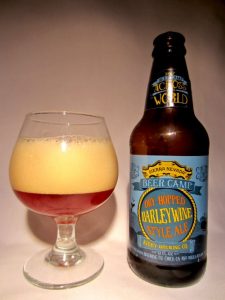 Description: Pours a big 2 ½ fingers of dense foamy head that lasts a full minute, leaving behind a bit of lacing over a nearly clear deep amber body. This dry-hopped barleywine leads with floral aromatics of marigold and dandelions, followed by spicy rye, sweet honey graham cracker, dry hop cones bursting with yellow resin-y lupulin glands, bran, light peach tea, cedar, baby pine cones, canned peaches, fresh cut bartlett pear, a hint of apricot, peach vanilla ice cream, and Cap’n Crunch cereal crunch berries. Malty sweet, full bodied and viscous as is typical of American Barleywines (medium carbonation). The flavor is a medium bitter, almost resinous hoppy character, with elements of black tea, vanilla ice cream, dried apricot, canned peach syrup, light toffee, perfume-y dried chamomile leaves and white pepper, leaving the entire mouth coated in hops and a touch of rye long into the aftertaste.
Description: Pours a big 2 ½ fingers of dense foamy head that lasts a full minute, leaving behind a bit of lacing over a nearly clear deep amber body. This dry-hopped barleywine leads with floral aromatics of marigold and dandelions, followed by spicy rye, sweet honey graham cracker, dry hop cones bursting with yellow resin-y lupulin glands, bran, light peach tea, cedar, baby pine cones, canned peaches, fresh cut bartlett pear, a hint of apricot, peach vanilla ice cream, and Cap’n Crunch cereal crunch berries. Malty sweet, full bodied and viscous as is typical of American Barleywines (medium carbonation). The flavor is a medium bitter, almost resinous hoppy character, with elements of black tea, vanilla ice cream, dried apricot, canned peach syrup, light toffee, perfume-y dried chamomile leaves and white pepper, leaving the entire mouth coated in hops and a touch of rye long into the aftertaste.
Label text: “Colorado’s Avery Brewing Co. and Sierra Nevada both make American-style barleywine ales verging on the hop extreme. For this collaboration-dubbed “Big Hog” as an homage to the two beers that inspired it-we recreated both barleywine recipes and then blended the beers into a new hop-heavy creation. It features rich, bittersweet malt character with notes of caramel and toffee balanced against a massive wall of hop flavor and is bottle conditioned for longevity.”
3. Hoppy Belgian-Style Golden (Sierra Nevada & Duvel Moortgat)
The Gist: Not as hoppy as the name suggests, but lemon is certainly noticeable and complimentary in the aroma and flavor of this generally well-crafted example of a Belgian Strong Golden Ale.
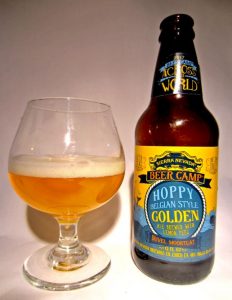 Description: Pours a thick finger of off-white fluffy, almost stiff egg white textured head that fades within 30 seconds over a clear deep yellow body (no yeast haze). Inviting aromatics of lemon angel food cake, candied lemon peel, lemon vanilla cake mix, lemon custard, lemon leaves, mild alcohol, light plantain or unripe starchy banana, Extra Pale dry malt extract, flour, mild alcohol and a hint of minty hops. Lemon character follows through in the flavor with notes of lemon custard, dried lemon zest, a touch of lemon-flavored vodka, some astringency and a citrusy hop character becoming more pronounced as it warms. A bit boozy for an ale of only 8% ABV. Aftertaste is dried banana chips, pith, radish, alcohol and grain husk. Medium-high carbonation and medium body.
Description: Pours a thick finger of off-white fluffy, almost stiff egg white textured head that fades within 30 seconds over a clear deep yellow body (no yeast haze). Inviting aromatics of lemon angel food cake, candied lemon peel, lemon vanilla cake mix, lemon custard, lemon leaves, mild alcohol, light plantain or unripe starchy banana, Extra Pale dry malt extract, flour, mild alcohol and a hint of minty hops. Lemon character follows through in the flavor with notes of lemon custard, dried lemon zest, a touch of lemon-flavored vodka, some astringency and a citrusy hop character becoming more pronounced as it warms. A bit boozy for an ale of only 8% ABV. Aftertaste is dried banana chips, pith, radish, alcohol and grain husk. Medium-high carbonation and medium body.
Label text: “Belgium’s Duvel are the masters of the golden ale-a beer style they helped create-so it was a natural fit for our breweries to combine the style with Sierra Nevada’s hop-forward fanaticism. The resulting beer is bright golden and brimming with hop flavor with a pop of bright lemon, and perfectly accented by the fruity and complex character of Duvel’s signature yeast.”
2. Campout Porter: (Sierra Nevada & Garage Project)
The Gist: Despite its name, no campfire smokiness present in this porter, though sipping many bottles of this brew next to a glowing fire would be well enjoyed. Sierra Nevada capitalizes on its knowledge of brewing a solid porter while Garage Project lends a touch of New Zealand with its addition of manuka wood and honey.
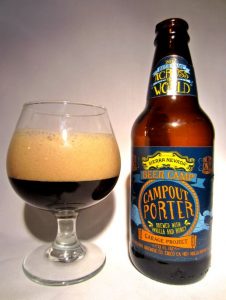 Description: Campout Porter pours a billowing two fingers of dense dark tan foam that holds its own for well over a minute, slowly revealing a dark brown body (22-24 SRM) with good clarity when held to the light. The aroma is an intriguing convergence of dusty dry mesquite wood, toasted pumpernickel bagel, radish, flax seed, hint of vanilla, subtle chocolate Frosty, light pine needle, pinecone resin, chocolate covered blueberries and cherries, wet bark, rich dark soil, with perhaps a hint of chocolate orange sticks. More so baker’s chocolate than coffee-like roasted malt in the flavor of this medium-low malty sweet porter. Imagine cold coffee slightly sweetened with vanilla ice cream followed by elements of barrel, light raisin, a touch of brown sugar, and prune skin finishing with mild alcohol warmth and dark chocolate, all of which muffles out any obvious honey character. Campout Porter closes with an aftertaste of baker’s chocolate, mesquite pods, volcanic rock and ash.
Description: Campout Porter pours a billowing two fingers of dense dark tan foam that holds its own for well over a minute, slowly revealing a dark brown body (22-24 SRM) with good clarity when held to the light. The aroma is an intriguing convergence of dusty dry mesquite wood, toasted pumpernickel bagel, radish, flax seed, hint of vanilla, subtle chocolate Frosty, light pine needle, pinecone resin, chocolate covered blueberries and cherries, wet bark, rich dark soil, with perhaps a hint of chocolate orange sticks. More so baker’s chocolate than coffee-like roasted malt in the flavor of this medium-low malty sweet porter. Imagine cold coffee slightly sweetened with vanilla ice cream followed by elements of barrel, light raisin, a touch of brown sugar, and prune skin finishing with mild alcohol warmth and dark chocolate, all of which muffles out any obvious honey character. Campout Porter closes with an aftertaste of baker’s chocolate, mesquite pods, volcanic rock and ash.
Label text: “In honor of Beer Camp, our friends at New Zealand’s Garage Project brewery wanted to carry the camping theme straight to the flavor of our beer. Featuring a unique malt smoked over manuka wood, rare manuka honey and vanilla beans, this robust porter has sweet notes reminiscent of marshmallows toasted over a campfire.”
1. Thai-Style Iced Tea Ale: (Sierra Nevada & Mikkeller)
The Gist: Spiced beers are one of the most unforgiving and difficult of beer styles to get right often faltering as a result of over-spicing, followed by mismatching the combination of spices in conjunction with the underlying beer style. Despite this, Sierra Nevada and Mikkeller swung for the fences with its Thai-Style Iced Tea ale, and against tough odds, delivered a memorable homerun in terms of balance, complexity, and creativity, masterfully capturing the essence of Thai-spiced iced tea in a beer.
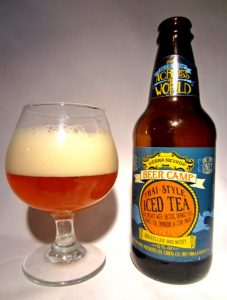 Description: Pours a fat finger of fluffy, manila folder-colored head, lasting about 40 seconds and leaving behind a bit of lacing over a clear medium amber-colored body. The aroma is first and foremost dried apricot, with notes of vanilla bean, faint clove, green tea ice cream, condensed milk, pleasant alcohol, apples stewed with Red Hot cinnamon candies, a dash of nutmeg, cardamom, brown sugar, caramel, ginger, allspice, and candied orange peel. Perhaps the most remarkable aspect about the flavor of this beer is the balance and show of restraint, with no single spice dominating, but all elements complimenting one another magnificently so. Medium fruity sweet flavor of yellow mango with a light sprinkle of nutmeg and paprika, dried star fruit, dried apricot skins, honey suckle nectar, mellow lactose, garam masala, peach vanilla ice cream, with an underlying character of Darjeeling green tea, leaving behind an aftertaste of peach schnapps, tannic chamomile and dandelion.
Description: Pours a fat finger of fluffy, manila folder-colored head, lasting about 40 seconds and leaving behind a bit of lacing over a clear medium amber-colored body. The aroma is first and foremost dried apricot, with notes of vanilla bean, faint clove, green tea ice cream, condensed milk, pleasant alcohol, apples stewed with Red Hot cinnamon candies, a dash of nutmeg, cardamom, brown sugar, caramel, ginger, allspice, and candied orange peel. Perhaps the most remarkable aspect about the flavor of this beer is the balance and show of restraint, with no single spice dominating, but all elements complimenting one another magnificently so. Medium fruity sweet flavor of yellow mango with a light sprinkle of nutmeg and paprika, dried star fruit, dried apricot skins, honey suckle nectar, mellow lactose, garam masala, peach vanilla ice cream, with an underlying character of Darjeeling green tea, leaving behind an aftertaste of peach schnapps, tannic chamomile and dandelion.
Label text: “Denmark’s Mikkeller brewery is famous for pushing the boundaries of beer, so when we decided to partner we knew the result would be a wild ride. This beer was inspired by flavors of a classic Thai Iced Tea. It;s sweet and rich, with warming spice notes and delicate fruit flavors that maintain a drinkability from the use of black tea in the finish.”
Beer-Inspired Thoughts
A spiced beer edging out an imperial hop-bomb?!?
BLASPHEMY!!!
We admit it: a big boozy barreled-aged whatever or a hop-drenched you-name-it is typically going to be the predetermined crowd-pleaser in many a beer circle. You don’t even need to taste the beers in question— just figure out which beer sounds the hoppiest/booziest, and crown it winner.
Indeed, not even some super certified beer judges are immune to the influence of popular taste.
True story: there was once a brewing competition where the judges were asked to determine which beer best represented the particular beer style it claimed to be. If you’ve never judged in a beer competition like this, the basic idea is not to score your personal favorite style of beer the highest, but instead to score a beer according to how well it represents the description spelled out in a pre-defined beer style guideline like the BJCP Beer Style Guidelines or the Brewer’s Association Beer Style Guidelines.
Sounds simple enough, right?
The decision for first place came down to two beers: a superior true-to-style fruit beer and a good but not as true-to-style Russian Imperial Stout. Which of the two beers took first place? Hint: Not the fruit beer. Why? Because according to the judges at the table, it would look weird to have a fruit beer beat out a Russian Imperial Stout, even though the fruit beer better represented the fruit beer category more so than the Russian Imperial Stout represented the Russian Imperial Stout category.
Is this fair? Not exactly, but imagine how weird it’d look if say a spiced beer were to ever beat out a super hoppy beer.
Yeah.
Hi, I’m Dan: Co-Founder and Beer Editor for BeerSyndicate.com, Beer and Drinking Writer, BJCP Beer Judge, Gold Medal-Winning Homebrewer, Beer Reviewer, AHA Member, Beer Traveler, and Shameless Beer Promoter.
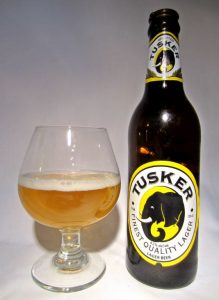 A hard pour into the center of a snifter glass barely managed to muster up a mere three millimeters of quickly fading off-white head over a clear pale apple juice-colored body. Aromatics include a hint of dry Kix cereal, faint tupelo honey, golden corn syrup, subtle malt, a note of flour, a touch of calcium and uncooked biscuit. Honey-forward flavor with a note of cream corn in a generally watery, but thirst-quenching, light-bodied Pilsner. Medium-high carbonation, medium-low sweetness and bitterness although absent of actual hop flavor, with an aftertaste of tupelo honey.
A hard pour into the center of a snifter glass barely managed to muster up a mere three millimeters of quickly fading off-white head over a clear pale apple juice-colored body. Aromatics include a hint of dry Kix cereal, faint tupelo honey, golden corn syrup, subtle malt, a note of flour, a touch of calcium and uncooked biscuit. Honey-forward flavor with a note of cream corn in a generally watery, but thirst-quenching, light-bodied Pilsner. Medium-high carbonation, medium-low sweetness and bitterness although absent of actual hop flavor, with an aftertaste of tupelo honey.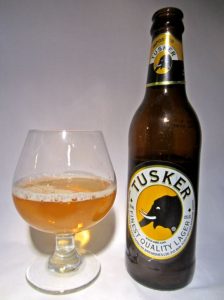 Pours a slightly hazy pale amber body forming about 1/8 inch of off-white frog-eyed head that fades in less than ten seconds. The aroma is reminiscent of cold but cooked butternut squash with a touch of maple syrup and a pad of butter, light brown sugar, no hops and no alcohol. Cooked squash is the main player in the flavor along with medium-sweet honey suckle nectar, watery Port wine, medium-low carbonation, no hop character, sweet graham cracker paste, Honey Smacks cereal, watery prunes, and wax paper with an aftertaste of white raisin and Port.
Pours a slightly hazy pale amber body forming about 1/8 inch of off-white frog-eyed head that fades in less than ten seconds. The aroma is reminiscent of cold but cooked butternut squash with a touch of maple syrup and a pad of butter, light brown sugar, no hops and no alcohol. Cooked squash is the main player in the flavor along with medium-sweet honey suckle nectar, watery Port wine, medium-low carbonation, no hop character, sweet graham cracker paste, Honey Smacks cereal, watery prunes, and wax paper with an aftertaste of white raisin and Port.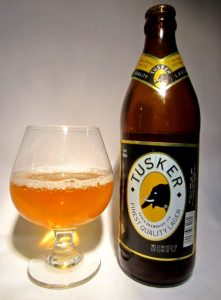 The lightly dusty bottle of twelve-year-old Tusker pours a slightly hazy deep gold body with an off-white film of head that fizzles out in under ten seconds. The aroma is suggestive of baklava, light raw squash with salt, cedar-aged cream soda, cold Lipton iced tea, honey, a hint of chlorine, peeled sweet potato, and cedar cigar box inside a humidor. Flavor impressions include honey, mild squash, light brown sugar, vanilla cream soda aged in cedar wood, medium-sweet cane sugar, inhaling an unlit honey-dipped cigarillo, Lipton “Brisk” iced tea with a light lemon tanginess, no hop character, and a touch of brown paper bag leaving behind an aftertaste of loose tobacco, subtle prune and white raisin.
The lightly dusty bottle of twelve-year-old Tusker pours a slightly hazy deep gold body with an off-white film of head that fizzles out in under ten seconds. The aroma is suggestive of baklava, light raw squash with salt, cedar-aged cream soda, cold Lipton iced tea, honey, a hint of chlorine, peeled sweet potato, and cedar cigar box inside a humidor. Flavor impressions include honey, mild squash, light brown sugar, vanilla cream soda aged in cedar wood, medium-sweet cane sugar, inhaling an unlit honey-dipped cigarillo, Lipton “Brisk” iced tea with a light lemon tanginess, no hop character, and a touch of brown paper bag leaving behind an aftertaste of loose tobacco, subtle prune and white raisin.
